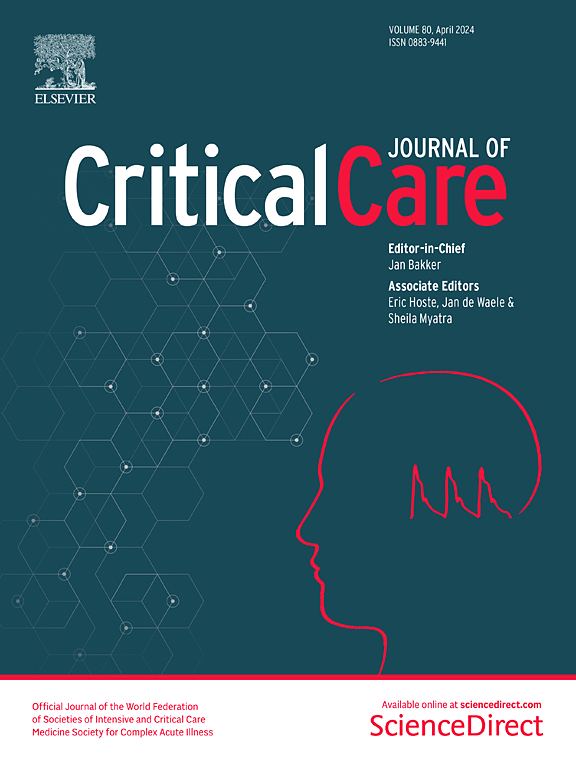非肾上腺素能性血管加压药物治疗血管扩张性休克或围手术期血管截瘫:随机对照试验的荟萃分析
IF 8.8
1区 医学
Q1 CRITICAL CARE MEDICINE
引用次数: 0
摘要
过量暴露于肾上腺素能性血管加压剂可能是有害的。非肾上腺素能性血管加压药物可以避免肾上腺素能性药物,并可能改善预后。我们的目的是对随机对照试验(RCTs)进行系统回顾和荟萃分析,以评估非肾上腺素能性血管加压药物在接受血管舒张性休克或围手术期血管截瘫血管加压治疗的成年患者中的疗效。我们检索了PubMed、Embase和Cochrane图书馆,以比较危重患者或围手术期患者使用非肾上腺素能性血管加压药与单独使用肾上腺素能性血管加压药或安慰剂的随机对照试验。每个符合条件的研究被分为感染性休克、心脏手术和非心脏手术。非肾上腺素能性血管加压素包括血管加压素、特利加压素、自我加压素、血管紧张素II、亚甲基蓝和羟钴胺素。主要结局是最长随访时的死亡率。我们进行了随机效应荟萃分析。我们在普洛斯佩罗国际前瞻性系统评价注册(CRD42024505039)中注册了该方案。在51项符合条件的随机对照试验中,共有5715例患者,其中30项研究的主要人群为感染性休克,11项研究为心脏手术,10项研究为非心脏手术。Cochrane随机试验风险偏倚工具第2版确定17项研究为低风险偏倚。在感染性休克中,非肾上腺素能组的死亡率明显较低(960/2232 [43%]vs. 898/1890 [48%];风险比[RR], 0.92;95%置信区间[95% CI], 0.86-0.97;p = 0.03;I2 = 0%),没有一种非肾上腺素能性血管加压药物显示出显著的生存益处。心脏手术患者的死亡率无显著差异(34/410 [8.3%]vs. 47/412 [11%];RR 0.82;95% ci, 0.55-1.22;p = 0.32;I2 = 12%)或接受非心脏手术(9/388 [2.3%]vs. 18/383 [4.7%];RR 0.66;95% ci, 0.31-1.41;p = 0.28;i2 = 0%)。非肾上腺素能性血管加压药物的使用与感染性休克患者死亡率的降低显著相关。然而,在单独的分析中,没有单一的药物达到统计学意义。尽管在接受心脏或非心脏手术的患者中,非肾上腺素能血管加压药物对生存的综合影响没有达到统计学意义,但置信区间包括了非肾上腺素能药物无影响和临床重要获益的可能性。这些发现证明了进一步的随机对照试验比较非肾上腺素能性血管加压药物与仅基于去甲肾上腺素的常规治疗。本文章由计算机程序翻译,如有差异,请以英文原文为准。
Non-adrenergic vasopressors for vasodilatory shock or perioperative vasoplegia: a meta-analysis of randomized controlled trials
Excessive exposure to adrenergic vasopressors may be harmful. Non-adrenergic vasopressors may spare adrenergic agents and potentially improve outcomes. We aimed to conduct a systematic review and meta-analysis of randomized controlled trials (RCTs) to evaluate the efficacy of non-adrenergic vasopressors in adult patients receiving vasopressor therapy for vasodilatory shock or perioperative vasoplegia. We searched PubMed, Embase, and Cochrane Library for RCTs comparing non-adrenergic vasopressors with adrenergic vasopressors alone or placebo in critically ill or perioperative patients. Each eligible study was categorized into septic shock, cardiac surgery, or non-cardiac surgery. Non-adrenergic vasopressors included vasopressin, terlipressin, selepressin, angiotensin II, methylene blue, and hydroxocobalamin. The primary outcome was mortality at longest follow-up. We conducted a random-effects meta-analysis. We registered the protocol in PROSPERO International Prospective Register of Systematic Reviews (CRD42024505039). Among 51 eligible RCTs totaling 5715 patients, the predominant population was septic shock in 30 studies, cardiac surgery in 11 studies, and non-cardiac surgery in 10 studies. Cochrane risk-of-bias tool for randomized trials version 2 identified 17 studies as low risk of bias. In septic shock, mortality was significantly lower in the non-adrenergic group (960/2232 [43%] vs. 898/1890 [48%]; risk ratio [RR], 0.92; 95% confidence interval [95% CI], 0.86–0.97; P = 0.03; I2 = 0%), with none of the individual non-adrenergic vasopressors showing significant survival benefits. No significant mortality difference was observed in patients undergoing cardiac surgery (34/410 [8.3%] vs. 47/412 [11%]; RR, 0.82; 95% CI, 0.55–1.22; P = 0.32; I2 = 12%) or those undergoing non-cardiac surgery (9/388 [2.3%] vs. 18/383 [4.7%]; RR, 0.66; 95% CI, 0.31–1.41; P = 0.28; I2 = 0%). Administration of non-adrenergic vasopressors was significantly associated with reduced mortality in patients with septic shock. However, no single agent achieved statistical significance in separate analyses. Although the pooled effects of non-adrenergic vasopressors on survival did not reach statistical significance in patients undergoing cardiac or non-cardiac surgery, the confidence intervals included the possibility of both no effect and a clinically important benefit from non-adrenergic agents. These findings justify the conduct of further RCTs comparing non-adrenergic vasopressors to usual care based on noradrenaline alone.
求助全文
通过发布文献求助,成功后即可免费获取论文全文。
去求助
来源期刊

Critical Care
医学-危重病医学
CiteScore
20.60
自引率
3.30%
发文量
348
审稿时长
1.5 months
期刊介绍:
Critical Care is an esteemed international medical journal that undergoes a rigorous peer-review process to maintain its high quality standards. Its primary objective is to enhance the healthcare services offered to critically ill patients. To achieve this, the journal focuses on gathering, exchanging, disseminating, and endorsing evidence-based information that is highly relevant to intensivists. By doing so, Critical Care seeks to provide a thorough and inclusive examination of the intensive care field.
 求助内容:
求助内容: 应助结果提醒方式:
应助结果提醒方式:


